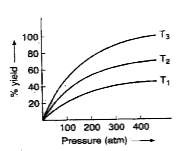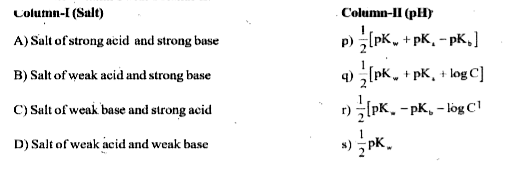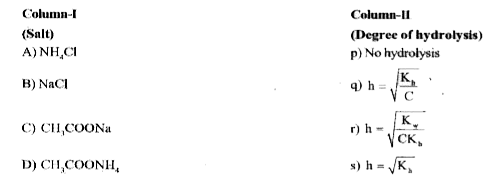Level - III (Linked Comprehension Type Questions) from BRILLIANT PUBLICATION CHEMICAL AND IONIC EQUILIBRIUM for Class 11
| Class 11 | CHEMISTRY |
| Chapter | CHEMICAL AND IONIC EQUILIBRIUM |
| BRILLIANT PUBLICATION | Level - III (Linked Comprehension Type Questions) |
| Medium | English |
| Academic Year | 2023-2024 |
Question 2
A 500 mL flask was charged with 1.0 mol of COCl2(g) and heated to some temperature (T) where decomposes partially as , COCl2(g)⇔CO(g)+Cl2(g),Kc(T)=1.5M
Now the above flask is connected to another flask containing some pure chlorine gas at the same temperature and pressure, by a narrow tube of negligible volume. When the equilibrium was restored, the concentration COCl2(g) was found to be 0.694 M. Determine the volume of Cl2(g) flask.View SolutionQuestion 4
0.2 mole of each Cl2(g) and F2(g) are introduced in a sealed flask and heated to 2000 K where following equilibirum established. Cl2(g)+F2(g)⇔2ClF(g), at equilibrium, moles of ClF = 0.267. At this stage 0.1 mole of Br2 is added and equilibrium is re-established as : Cl2(g)+F2(g)⇔2ClF(g),Cl2(g)+Br2(g)⇔2BrCl(g). Now moles of ClF is found to be 0.25. Calculate Kc for the second equilibrium reaction.View SolutionQuestion 6
The [H+] in 0.2 M solution of formic acid is 6.4×10−3 mol litre−1. To this solution formate is added so as to adjust the conc. of sodium formate to one mol per litre. What will be pH of this solution ? Ka for HCOOH is 2.4×10−4 and degree of dissociation of HCOONa is 0.75. : 2.32, 6.29, 4.19, 1.57View SolutionQuestion 7
An acid type indicator HIn differs in colour from its conjugate base (In−). The human eye is sensitive to colour differences only when the ratio (In−)/[Hin) is greater than 10 or smaller than 0.1. What should be the minimum change in the pH of the solution to observe a complete colour change (Ka=1.0×10−5) ? : 3, 4, 1, 2View SolutionQuestion 9
2M solution of Na2CO3 is boiled in a closed container with excess of CaF2. Very little amount of CaCO3 and NaF are formed. If the solubility product of CaCO3 is x and molar solubility of CaF2 is y, find the molar concentration of F− in the resulting solution after equilibrium is attained.View SolutionQuestion 12
The thermal dissociation equilibrium of CaCO3(s) is studied under different conditions
CaCO3(s)⇔CaO(s)+CO2(g)
For this equilibrium , the correct statements are : ΔH is dependent on T, K is dependent on the pressure of CO2 at a given T, K is independent of the initial amount of CaCO3, ΔH is independent of the catalyst, if anyView SolutionQuestion 17
Which of the following statements are correct ?The pH of 1.0×10−8M solution of HCl is 8, The conjugate base of H2POɵ4 is HPO2−4, The autoprotolysis constant of water increases with temperature, Whan a solution of a weak monoprotic acid is treated against a strong base, at half-neutralisation point, pH =(1/2)pKa.View SolutionQuestion 35
Statement 1 : HF is weaker acid as compared to H3BO3.
Statement 2 : Higher the ionisation constant stronger is the acid. : Statement 1 is True, statement 2 is True, Statement 2 is correct explanation for Statement 1.; Statement 1 is True, statement 2 is True, Statement 2 is NOT a correct explanation for Statement 1.; Statement 1 is True, statement 2 is false.; Statement 1 is False, Statement 2 is True.View SolutionQuestion 38
Statement 1: State of equilibrium of a system can not be changed by some external factors such as pressure, volume concentration.
Statement 2 : Any change in the state of equilibrium caused by external factors is nullified by the system. : Statement 1 is True, statement 2 is True, Statement 2 is correct explanation for Statement 1.; Statement 1 is True, statement 2 is True, Statement 2 is NOT a correct explanation for Statement 1.; Statement 1 is True, statement 2 is false.; Statement 1 is False, Statement 2 is True.View SolutionQuestion 40
The dissociation of weak electrolyte (weak acid) is expressed in terms of Ostwald dilution law. Stronger is the acid, weaker is its conjugate base. The dissociation constants of an acid (Ka) and its conjugate base (Kb) are related by the given relation : Kw=Ka×Kb
At 25∘C,Kw (Ionic product of water ) =1014. Phosphoric acid is a weak acid. it is used in fertilizer, food, detergent and toothpaste. Structure of phosphoric acid is :
 (pKa1=2.12,pK2=7.21,pKa3=12.32)
(pKa1=2.12,pK2=7.21,pKa3=12.32)
Aqueous solution of phosphoric acid with a density of 1gmL−1 containing 0.05% by weight of phosphoric acid is used to impart taste to many soft drinks.
Phosphate ion is an interfering radical in qualitative analysis. It should be removed for analysis beyond third group of qualitative analysis.
Which among the following relations is correct ?View SolutionQuestion 42
In Haber's process, ammonia is manufactured according to the following reaction
N2(g)+3H2(g)⇔2NH3(g),ΔH∘=−2.4kJ
The pressure inside the chamber is maintained at 200 atm and temperature at 500∘C. Generally this reaction is carried out in presence of Fe catalyst.
If Kp for the given reaction is 1.44×10−5, then the value of Kc will be :View SolutionQuestion 43
In Haber's process, ammonia is manufactured according to the following reaction
N2(g)+3H2(g)⇔2NH3(g),ΔH∘=−2.4kJ
The pressure inside the chamber is maintained at 200 atm and temperature at 500∘C. Generally this reaction is carried out in presence of Fe catalyst.
The preparation of ammonia by Haber's process is an exothermic reaction. If the preparation follows the following temperature pressure relationship for its % yield. Then for temperature T1,T2 and T3, the correct option is :
 View Solution
View SolutionQuestion 44
In Haber's process, ammonia is manufactured according to the following reaction
N2(g)+3H2(g)⇔2NH3(g),ΔH∘=−2.4kJ
The pressure inside the chamber is maintained at 200 atm and temperature at 500∘C. Generally this reaction is carried out in presence of Fe catalyst.
500∘C is considered optimum temperature for Haber's process because : catalyst has maximum activity at this temperature, energy required is easily obtained at this temperature, yield is maximum at this temperature, rate is fast enough while the yield is also appreciable at this temperatureView SolutionQuestion 45
10 mole of NH3 is heated at 15 atm from 27∘C to 347∘C assuming volume constant. The pressure at equilibrium is found to be 50 atm. The equilibrium constant for dissociation of NH3 :
2NH3⇔N2+3H2,ΔH=91.94kJ can be written as Kp=pN2×(pH2)2(P2NH3)(atm)2
The degree of dissociation of NH3 is :View SolutionQuestion 46
10 mole of NH3 is heated at 15 atm from 27∘C to 347∘C assuming volume constant. The pressure at equilibrium is found to be 50 atm. The equilibrium constant for dissociation of NH3 :
2NH3⇔N2+3H2,ΔH=91.94kJ can be written as Kp=pN2×(pH2)3(P2NH3)(atm)2
The equilibrium constant Kp for the reaction is :View SolutionQuestion 47
10 mole of NH3 is heated at 15 atm from 27∘C to 347∘C assuming volume constant. The pressure at equilibrium is found to be 50 atm. The equilibrium constant for dissociation of NH3 :
2NH3⇔N2+3H2,ΔH=91.94kJ can be written as Kp=pN2×(pH2)2(P2NH3)(atm)2
The increase in pressure and temperature on the reaction in equilibrium favours :View SolutionQuestion 48
The degree of dissociation of weak electrolyte is inversely proportional to the same square root of concentration. What is called Ostwald's dilution law.
α=√Kac As the temperature increases, degree of dissociation will increase.
α1α2=√Ka1Ka2 if concentration is same. α1α2=√c2c1 if acid is same.
0.01 M CH3COOH has 4.24% degree of dissociation, the degree of dissociation of 0.1 M CH3COOH will be View SolutionQuestion 49
The degre of dissociation of weak electrolyte is inversely proportional to the same square root of concentration. What is called Ostwald's dilution law.
α=√Kac As the temperature increases, degree of dissociation will increase.
α1α2=√Ka1Ka2 if concentration is same. α1α2=√c2c1 if acid is sam.
pH of 0.005 M HCOOH [Ka=2×10−4] is equal to : 3, 2, 4, 5View SolutionQuestion 50
The degre of dissociation of weak electrolyte is inversely proportional to the same square root of concentration. What is called Ostwald's dilution law.
α=√Kac As the temperature increases, degree of dissociation will increase.
α1α2=√Ka1Ka2 if concentration is same. α1α2=√c2c1 if acid is sam.
For two monobasic acids HA1 and HA2 at the same concentration α1 and α2 are in ratio of 1:2. Ka1=2×10−4. What will be Ka2 ? 8×10−4, 2×10−4, 4×10−4, 1×10−4View Solution
All Exercises from BRILLIANT PUBLICATION Class 11 CHEMISTRY CHEMICAL AND IONIC EQUILIBRIUM
- LEVEL - I (HOMEWORK)
- QUESTIONS
- LEVEL - II
- LEVEL - II (ASSERTION-REASON)
- LEVEL -I
- LEVEL-I
- LEVEL -II
- LEVEL-II
- LEVEL-II (ASSERTION-REASON TYPE)
- LEVEL - III
- LEVEL - III (LINKED COMPREHENSION TYPE QUESTIONS)
- LEVEL - III (LINKED COMPREHENSION TYPE)
- LEVEL - III (MATRIX MATCH TYPE)
- LEVEL - III (NUMERICAL TYPE)
- LEVEL - III (STATEMENT TYPE)





